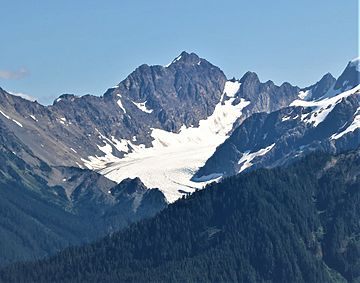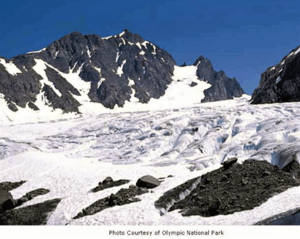Mount Mathias facts for kids
Quick facts for kids Mount Mathias |
|
|---|---|

Mt. Mathias, from NNW
|
|
| Highest point | |
| Elevation | 7,156 ft (2,181 m) |
| Prominence | 996 ft (304 m) |
| Isolation | 0.97 mi (1.56 km) |
| Parent peak | Mount Olympus (7,980 ft) |
| Geography | |
| Location | Olympic National Park Jefferson County, Washington, US |
| Parent range | Olympic Mountains |
| Topo map | USGS Mount Olympus |
| Geology | |
| Age of rock | Eocene |
| Climbing | |
| First ascent | 1957 by |
| Easiest route | class 4 climbing via West Face |
Mount Mathias is a tall mountain peak in Olympic National Park, Washington state. It stands about 7,156 feet (2,181 meters) high. This mountain is located in Jefferson County. Its closest and taller neighbor is Mount Olympus, which is about 1.76 miles (2.83 km) to the east. Mount Mathias sits between two large glaciers: the Blue Glacier on its west side and the Hoh Glacier on its east side. Water from the mountain flows into the Hoh River.
The Story Behind the Name
This mountain was first called "Apollo". This name came from Greek and Roman mythology. Apollo was one of the Olympian gods who lived on Mount Olympus.
The mountain was later renamed to honor Francis Wayland "Matt" Mathias. He lived from 1884 to 1959. Matt Mathias was a mountaineer, a nature lover, and a leader in Grays Harbor County. The new name, Mount Mathias, was officially approved in 1960. This was done by the U.S. Board on Geographic Names.
The very first time someone climbed to the top of this peak was in 1957. Two climbers, Yves Eriksson and Jim Hawkins, made this first ascent.
Mountain Weather
Mount Mathias is in a marine west coast climate zone. This type of climate is found in western North America. Most weather systems start over the Pacific Ocean. They then travel northeast towards the Olympic Mountains.
As these weather systems reach the mountains, the peaks force them upward. This causes them to release their moisture as rain or snow. This process is called Orographic lift. Because of this, the Olympic Mountains get a lot of rain and snow. This is especially true during the winter months.
In winter, the weather is often cloudy. But in summer, high pressure systems over the Pacific Ocean become stronger. This often leads to clear skies. The best time to visit or climb Mount Mathias is usually from July through September.
How the Mountain Formed
The Olympic Mountains are made of different types of rock. These include sandstone, turbidite, and basalt. These rocks formed from ocean crust during the Eocene period.
Over time, during the Pleistocene era, glaciers helped shape the mountains. These huge ice sheets moved forward and then retreated many times. This process of erosion created the mountain shapes we see today.




